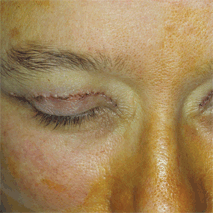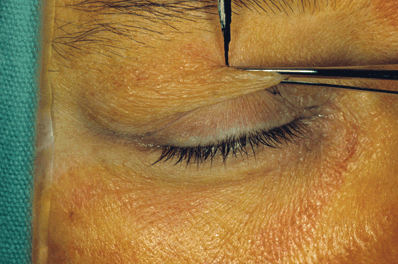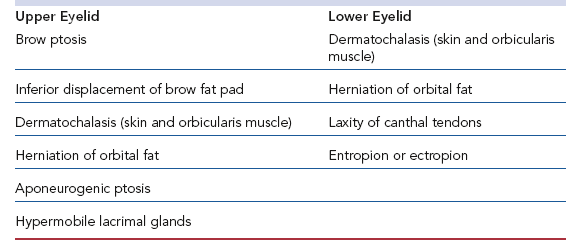10 Upper Eyelid Blepharoplasty

PREOPERATIVE EVALUATION
The Periorbital Relaxation Syndrome
The majority of patients who present to the ophthalmologist for correction of “fullness” of the upper eyelids do so because of a constellation of abnormalities, best termed the periorbital relaxation syndrome. These patients will, to a greater or lesser degree, exhibit anatomic disturbances of all the supporting structures of the orbital unit and are best viewed as part of a continuum. Manifestations of this syndrome in the upper lid include dermatochalasis (lax eyelid skin and underlying orbicularis muscle), herniation of orbital fat, true ptosis, inferior displacement of eyebrow fat with or without eyebrow ptosis, and hypermobile lacrimal glands (Table 10.1). In the lower eyelid, manifestations include dermatochalasis, herniation of orbital fat, canthal laxity, and entropion or ectropion.
Current understanding has added the concept of “deflation” to that of relaxation. While in the past, most of our efforts were directed toward the subtraction of presumed excess tissue, the reality of the situation is considerably more complex. Optimum upper eyelid blepharoplasty is evolving at the time this chapter is written. Tissue rearrangement, or even addition, may be necessary to restore youthful appearance and function.
The preoperative evaluation must recognize the level of participation of each of these components of this syndrome in each individual patient so that effective surgery can be planned. It is most helpful to sequentially tape structures into normal anatomic position to unmask the extent of involvement of other structures. It is essential for the surgeon to think in three dimensions, particularly in regard to the impact abnormalities of the forehead and brow may have on the upper eyelid anatomy and function.
Associated Ophthalmic Abnormalities
It is obvious to the ophthalmic surgeon that all patients who present for eyelid surgery need a complete ophthalmic examination. Planned alterations in eyelid anatomy may have significant implications for ophthalmic function. For patients in whom upper eyelid blepharoplasty is contemplated, particular attention needs to be focused on assessment of tear quality and quantity, presence or absence of a protective Bell’s response, and possible underlying corneal lesions in which increased exposure may have import. Alterations in lid position and function may affect contact lens fitting after surgery.
The cause of the periorbital relaxation syndrome is multifactorial. In many instances, it is associated with solar elastosis, or the loss of elastic fibers in the dermis secondary to cumulative exposure to sun and weather. Such patients are also at risk for development of actinic keratoses and basal cell carcinoma.
Thyroid-associated orbitopathy commonly causes marked herniation of orbital fat, with concomitant relaxation of supporting structural elements of the orbital unit. In addition, such patients exhibit increased orbital vascularity, which may technically complicate the surgery.
The relatively rare condition of true blepharochalasis can be recognized by periodic, often unilateral, episodes of inflammatory edema of the eyelids without other cause. The repeated mechanical swelling causes a condition that mimics isolated acceleration of the normal aging process of the orbital unit.
Periorbital edema can result from generalized edema caused by metabolic, cardiac, or hematologic abnormalities. It is also seen in a localized idiopathic form, and it can be confused with the fullness or orbital fat herniation. Rare causes of periorbital edema include the Melkersson-Rosenthal and Ascher’s syndromes, both with associated edema of the lips, buccal mucosa, or other parts of the face.
SURGICAL INDICATIONS
Objective Indications
A somewhat arbitrary distinction can be made between “reconstructive” blepharoplasty and “aesthetic” blepharoplasty. The reality is that most patients seeking relief of objective symptoms are also very concerned with achieving an optimum aesthetic result.
Perhaps the most persistent and easily quantified objective indication for upper eyelid blepharoplasty is a peripheral visual field defect. Many patients will volunteer that they can see much better when they manually elevate the upper eyelid. Visual field testing, with and without eyelid taping, will objectively document the presence of the peripheral field defect, as well as the expected improvement with surgery. Preoperative photography, taken in full-face and lateral or three-quarter views, can further document the existence of objective abnormality. Most insurance companies now demand such objective evidence for certification of the reconstructive nature of the proposed surgery.
Subjective Indications
In the preoperative evaluation of the upper eyelid blepharoplasty, it is absolutely essential to identify the patient’s expectations of surgery and to balance these against realistic surgical goals. A blepharoplasty will not improve brow ptosis, nor is it a substitute for a facial rhytidectomy. It may be helpful to give the patients hand mirrors and ask them to point out their expectations of surgery. All patients undergoing upper eyelid blepharoplasty need to be given a detailed informed consent form that includes the planned surgical procedure, its goals, anticipated benefits, and possible risks.
SURGICAL ANATOMY
The relatively thin, uniform skin of the upper eyelid merges with thicker skin at the nose, eyebrow, and lateral orbital rim. Ideally, the skin excision in upper eyelid blepharoplasty should be confined to this area of thin skin. In distinction to other areas of the face, there is no subcutaneous fat in the eyelid, with tight adhesion between lid skin and the underlying thin anterior investing fascia or the orbicularis muscle. This adhesion effectively joins the skin and orbicularis as a single unit.
The upper eyelid crease and overhanging fold divide the eyelid into a tarsal and orbital portion. Below this crease, pretarsal orbicularis muscle is tightly adherent to, in turn, the postorbicular fascia, levator aponeurosis, and tarsus. Superior traction on the skin in this region will be directly transmitted to the underlying layers.
Above the lid crease, preseptal and orbital portions of the orbicularis are also adherent to the underlying postorbicular fascia. However, the adherence to the underlying orbital septum is tenuous, and superior traction on skin in this area will elevate the skin, muscle, and fascia away from the orbital septum.
Formation of the lid crease is classically ascribed to skin attachments of the levator aponeurosis extending through the orbicularis muscle to terminate in the dermis. An alternative theory explains the formation of the lid crease as a union of the postorbicular fascia with the levator aponeurosis.
Perhaps the most clinically useful landmark in upper eyelid surgery is the orbital septum. This nonelastic connective tissue membrane arises from the arcus marginalis at the orbital rim and extends inferiorly to terminate and insert upon the levator aponeurosis. The exact point of attachment is variable, with inferior termination largely responsible for formation of the Oriental upper eyelid. Beneath the septum is the orbit proper, with variable amounts of orbital fat, divided into a preaponeurotic portion and a medial portion, split by the tendon of the superior oblique muscle and associated fascia. No true “lateral” fat compartment is present, although the preaponeurotic portion may extend laterally over the anterior aspect of the lacrimal gland.
Anterior to the septum is the postorbicular fascia, in which run the terminal fibers of the trigeminal nerve. This layer may also contain considerable fat, contiguous with the eyebrow fat pad. The presence of such “preseptal” fat, especially laterally, is probably responsible for the elusive lateral fat compartment of the upper eyelid. This fat, unlike the easily prolapsed orbital fat, is contained within fibrous septa.
The levator aponeurosis fans out from the muscular portion of the levator, and inserts in a broad attachment along the anterior surface of the tarsus, with possible extensions to the skin, as described by Whitnall. The lateral expansion, or horn, splits the orbital and palpebral portions of the lacrimal gland to join the lateral retinaculum and insertion on Whitnall’s lateral orbital tubercle. The course of the medial expansion is less delineated, but function attachments to the medial canthal tendon exist.
The orbital portion of the lacrimal gland occupies the lacrimal gland fossa and is held in place by “ligaments,” or capsular connections within the orbital connective tissue network, particularly at its posterior extent.
An important precept that follows from knowledge of upper eyelid anatomy is that alterations of anatomy will produce alterations in form and function. Indeed, that is the purpose of upper eyelid blepharoplasty. Most patients want a more youthful appearance. Although some Oriental patients may desire an Occidental appearance postoperatively, to create such an appearance when it is not desired will have disastrous consequences.
To this end, it is most important to plan the surgical incision to coincide with the desired eyelid crease, as the closure of this incision will locally unite the orbicularis muscle, postorbicular fascia, and levator aponeurosis. Superior traction on this unit produced by levator contraction will create the lid crease and associated lid fold. Most women desire this crease to be high. Most men would be very unhappy with such a “feminine” lid. The crease in the Oriental patient may be only a few millimeters from the cilia.
SURGICAL PROCEDURE
General Preparation of Patient
In most patients, upper eyelid blepharoplasty should be done under local anesthesia with intravenous relaxation. Provisions for monitoring vital functions, optimally to include pulse oximetry, must be made. Medications with anticoagulant properties, particularly aspirin, should be discontinued at least 7 days before surgery. If this is medically impossible, the intraoperative use of topical hemostatic agents, such as thrombin, should be anticipated.
Following intravenous relaxation and application of topical ophthalmic anesthetic, the patient is prepared in a sterile fashion for lid surgery. Care is exercised in the draping of the patient, to avoid artificial tension of the eyelid from the drape.
Although some surgeons successfully inject local anesthetic before skin margin and preparation, the distortion produced by the injection may make accurate skin margin impossible.
Surgical Technique
With superior traction on the skin at the brow, the redundant skin and orbicularis muscle is effaced. The site of incision and proposed upper eyelid crease is marked, extending from the lacrimal punctum to the lateral palpebral commissure. In the male patient, the crease should be marked approximately 7.5 to 8.0 mm from the lid margin at its highest extent in midlid. The crease in female patients is higher, approximately 9.0 to 9.5 mm from the lid margin. In both male and female patients, the medial and lateral extremes of the lid crease are approximately 1.0 to 1.5 mm lower than its central height. From the lateral termination of the lid crease incision marking, an extension is drawn at about a 20° angle, terminating at the outside border of the lateral orbital rim.

Figure 10-1. At several points along the lid crease incision, the redundant skin and underlying orbicularis are grasped with a smooth forceps. The forceps is closed at various levels until the amount of skin pinched eliminates excessive eyelid skin and minimally everts the lashes. The points are marked with the marking pen and are then connected to create an ellipsoid segment to be excised.
Stay updated, free articles. Join our Telegram channel

Full access? Get Clinical Tree



